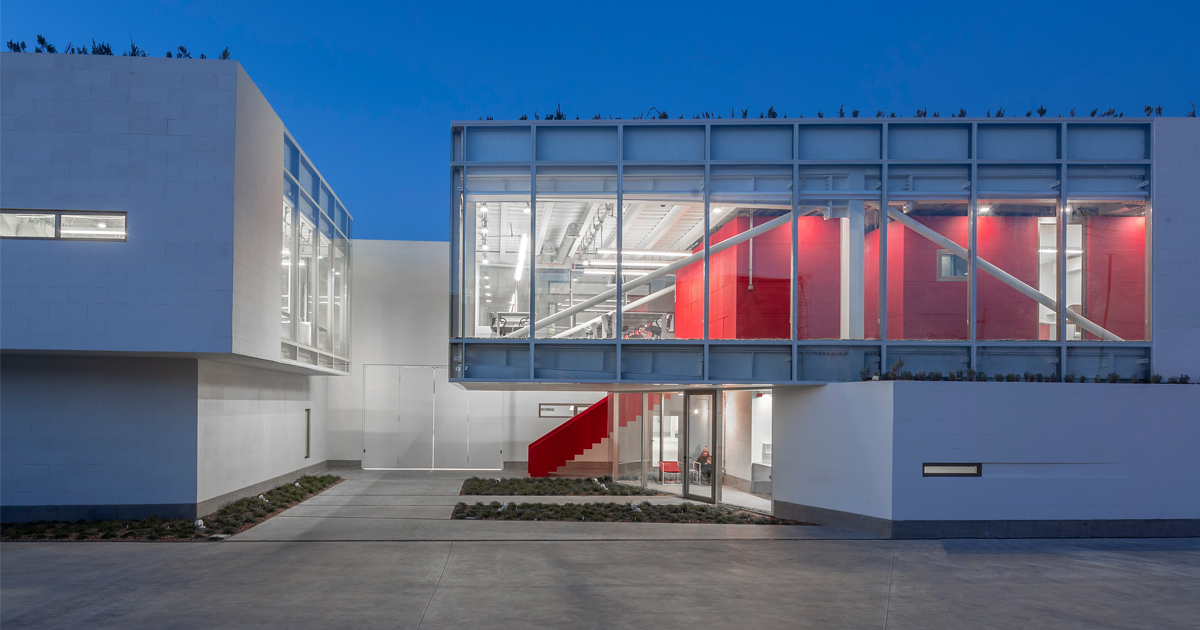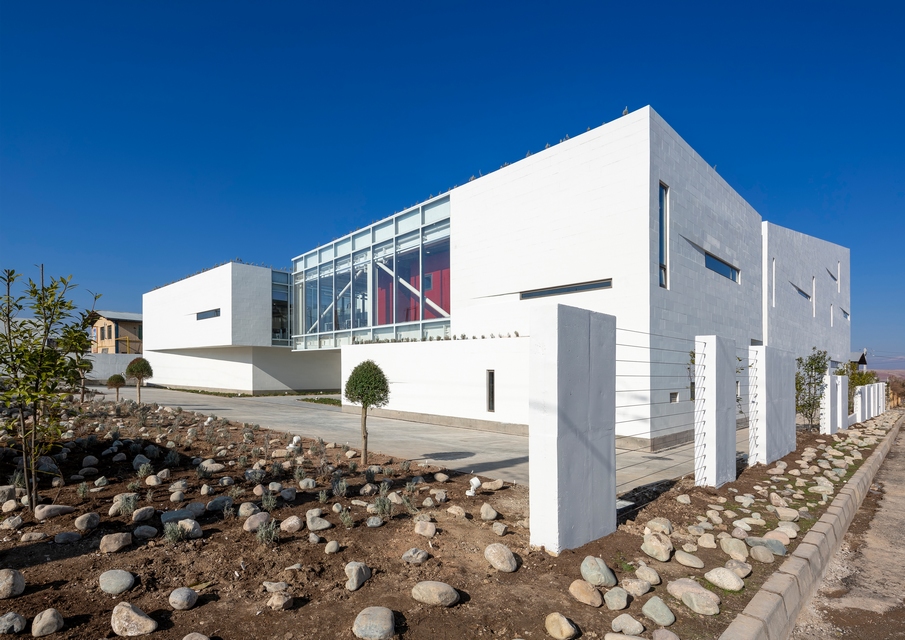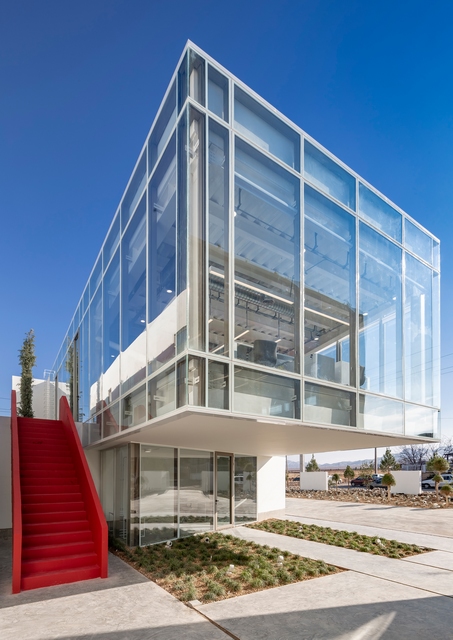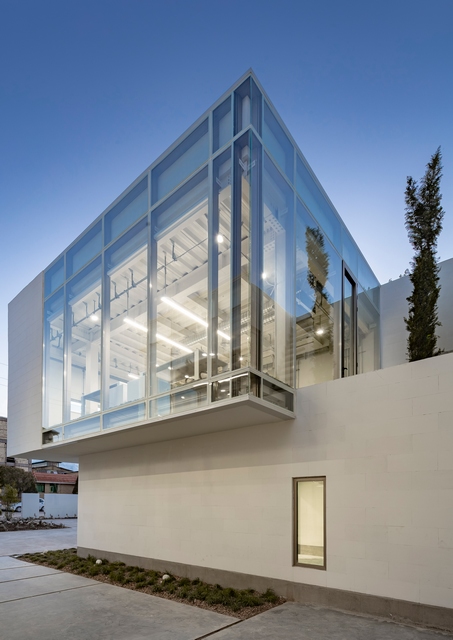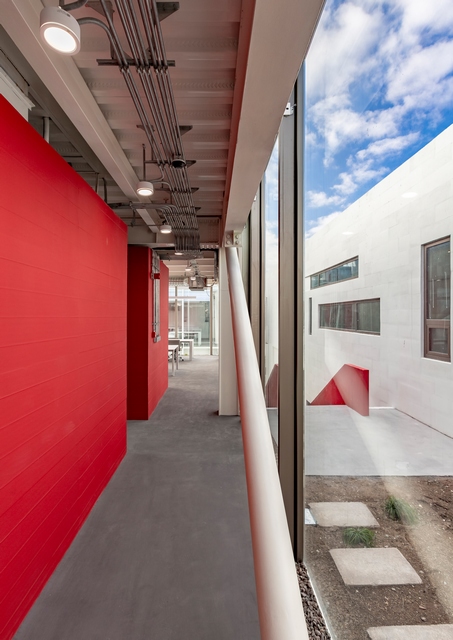Shamim Polymer Factory | Davood Boroojeni Office | World Design Awards 2021
Davood Boroojeni Office: Winner of World Design Awards 2021. The project proposal is related to a factory for the production of polymeric materials. The factory has a production, office and research department. The project land is approximately square like (60 meters long and 50 meters wide) is limited to the neighbor in the north and west and to the street in the south and east. This land with an area of three thousand square meters is located in a small industrial town in Alborz province of Iran.
The lack of architectural separation for different work activities in Iranian factories is the major reason for the low quality of living spaces for such functions. As a factory has multiple work spaces and resultantly houses a range of staff from laborer to lab specialists, the architectural quality of connecting spaces which also plays the role of separating different activity areas is of crucial importance. However, majority of industrial buildings in Iran have integrated structure and the only dividing area for different functions are interior walls.
This project seeks to solve this problem by increasing sense of connecting spaces to improve the quality of life of factory workers.
The concept of this complex took place in two outdoor void spaces perpendicular to each other. One void stretches south to north and the other empty space stretches east to west.
The geometry of these void spaces makes separation of different parts possible and acts as a middle courtyard for connecting different areas with each other.
Human dimensions, open air, light and shadow, green space and color increase the sense of middle courtyard. Different sections with glass walls or windows overlook the middle courtyard and improve its psychological security.
In choosing construction materials, their purity has been considered. Floors are made of concrete and steel, walls are made of prefabricated concrete blocks,
glass and prefabricated concrete panels, and stairs are made of cast in place concrete. Without any other materials.
When the materials had been chosen, their purity has been considered. Floors are made of concrete, walls are made of prefabricated concrete blocks, glass and prefabricated panels are made of concrete without any other materials have added to them. The uses of exposed materials not only creates an industrial feel in the spaces, also makes less harm to the environment.
In Iran, there have been specific patterns for organizing building plans from the past. The middle courtyard and the cruciform axes are two important patterns in Iranian architecture. These two patterns are still used today in design of buildings with residential, administrative, multi- purpose, parks, etc., but their traces are disappeared in
today’s industrial architecture of Iran. There are documents indicated that these two patterns were used about 400 years ago and in the historical era of Safavid in the industrial uses’ design. The factories of that eras, called BIOTAT, had two axes perpendicular to each other and have a courtyard in the middle. It is believed that the prediction of these two patterns in the architectural design of Shamim Polymer factory is an attempt to revitalize these two Iranian architectural methods in industrial uses.
Things such as the desired spatial quality, local architecture, climate, and exposed usage of materials have been considered in the Shamim Polymer factory’s design. We believe that the beautiful, innovative, and useful architecture of the Shamim Polymer factory is the result of using the above mentioned simultaneously.
Interior void in the production sector increases its spatial quality. The second floor bridges are a place to watch and visit the production sector on the first floor.
The most important challenge in designing industrial uses, given the wide range of their employees from simple workers to laboratory specialists, is the proper separation of different workspaces and implementing hierarchical access. Our studies have shown that lack of proper placement in different uses relative to each other
has reduced significantly the efficiency of production, and requires more energy and manpower to compensate for it. For this purpose, instead of a wall, we used space to separate different parts. The middle courtyard’s prediction helped to separate various parts of
the factory properly, including the administrative, the laboratory and the production areas. Other challenge was the possibility of leaving this middle courtyard abandoned. To meet this challenge, we increased the spatial quality of the middle courtyard by observing human dimensions, considering open air for it, predicting the light and shadow play, green space and color.
The context of design has consisted of cold winters with strong western winds and hot summers. Reducing energy consumption through architectural solutions has been a main concern during design of the factory. For this purpose, we have used materials with low heat transfer coefficient for the walls. The chosen color for the outer shells was white with the aim of minimizing absorption of solar radiation in summer.
Our other solution for reducing energy consumption is the green roof of the administrative part of the factory. In December, we have checked the outside air temperature and the administrative area daily. The lowest temperature of the outside area for this month is minus 8 degrees, while the lowest temperature of the inside area without use of heating devices has been recorded at 12 degrees Celsius.
The courtyard is placed in the middle, laboratory on the left side, and administrative area in right side. The red stairs made of concrete allows the main access to the administrative area. The administrative area with 8.5 meters long is in the middle courtyard of the console.
There is a view to the administrative area from the middle courtyard. The glass walls of administrative area provide psychological security for the middle courtyard. Human dimensions, open air, light and shadow, green space, and color increase the spatial quality of the middle courtyard.
The audience will encounter first with two consoles of the building. The empty space between the two consoles is defining the main entrance. The small guardhouse can be seen on the left side.
The administrative area is predicted in the consoled glass volume. Glass walls allow a wide administrative view to the courtyard and other parts of the factory.
The laboratory has its private courtyard with the Cypress tree on the second floor.
Project Details
Firm
Davood Boroojeni Office
Project Name
Shamim Polymer Factory
Architect/Designer
Davood Boroojeni
World Design Awards Category
Other (Industrial Architecture)
Project Location
Karaj
Team
Davood Boroojeni, Saba Ammari, Hamed Kalate
Country
Iran
Photography ©Credit
©Parham Taghioff
 As a technically competent architecture firm with over 15 years of professional experience, we have been involved in different stages of architectural projects including the conception of preliminary design ideas, schematic design and design development, as well as producing submittal packages, visual presentations, construction documents, layouts and details through close dialogue with clients, producers, and other engineers. We believe that our communication skills, public relations, and problem-solving experience, combined with our background in ability to research, schedule, and coordinate design in various stages of the project, has made us a firm to depend on, and a key team member.
As a technically competent architecture firm with over 15 years of professional experience, we have been involved in different stages of architectural projects including the conception of preliminary design ideas, schematic design and design development, as well as producing submittal packages, visual presentations, construction documents, layouts and details through close dialogue with clients, producers, and other engineers. We believe that our communication skills, public relations, and problem-solving experience, combined with our background in ability to research, schedule, and coordinate design in various stages of the project, has made us a firm to depend on, and a key team member.


